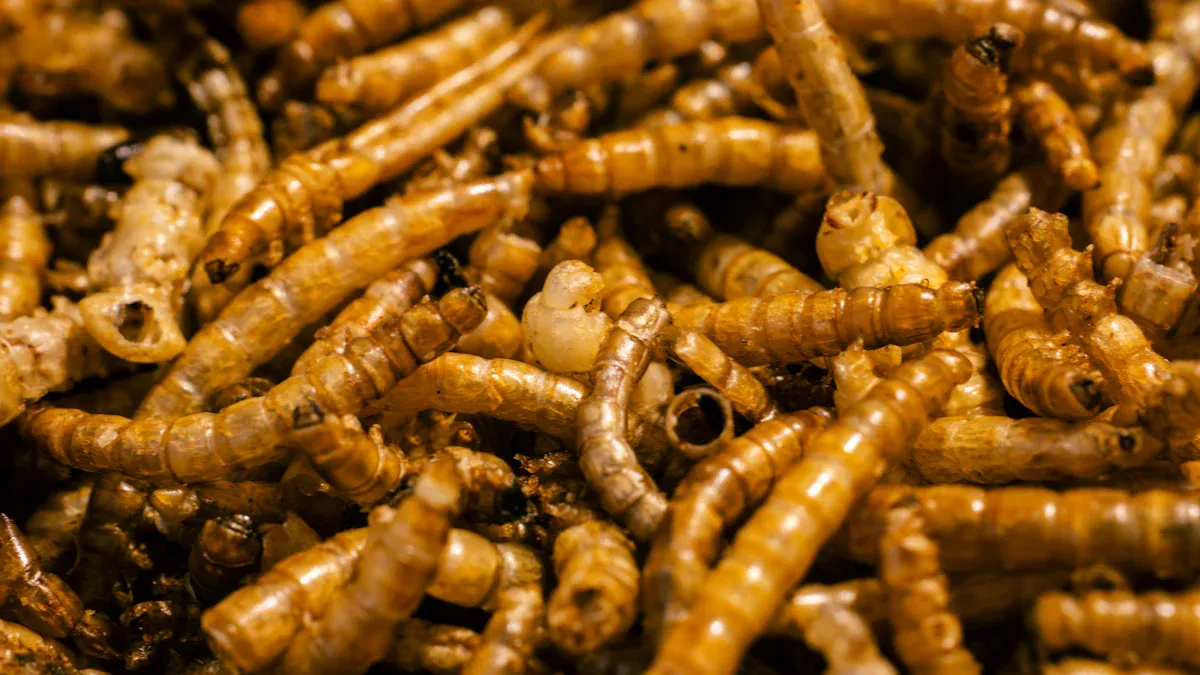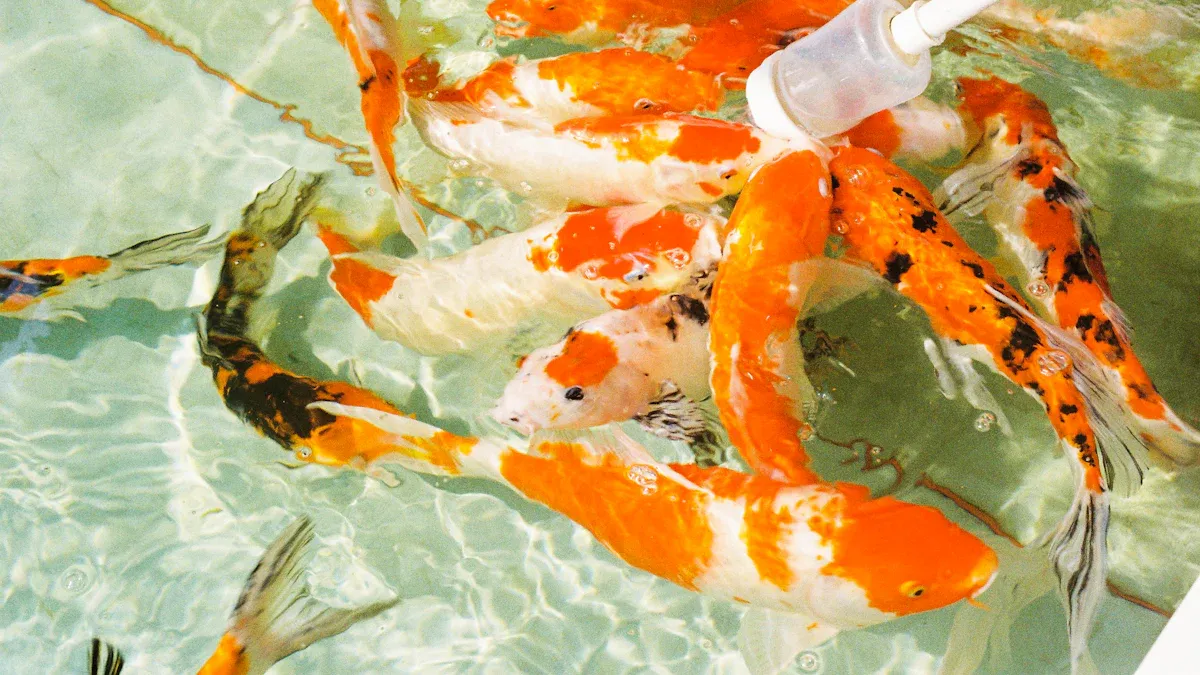
Dried mealworms are a powerhouse of nutrition for fish. Packed with approximately 50% protein and 33% lipids, they deliver the perfect balance of energy and essential nutrients. Their fatty acid profile, dominated by oleic and linoleic acids, ensures a rich source of unsaturated fats. With a long shelf life and eco-friendly production, they’re an excellent choice for sustainable fish feeding.
Did you know? Mealworms contain up to 60% protein and 43% lipids, making them one of the most nutrient-dense options available for aquatic pets.
Natural Protein dried mealworms for fish offer an easy way to enhance your pets’ diets while reducing waste and environmental impact.
Key Takeaways
- Dried mealworms are a healthy food for fish. They have up to 60% protein and 43% fats, which give energy and help fish grow.
- Adding mealworms to fish food can make fish healthier. It boosts their immune system and helps them live better in different environments.
- Mealworms are eco-friendly and need fewer resources than regular animal feed. This helps both the fish and the planet.
Nutritional Benefits of Natural Protein Dried Mealworms for Fish
High Protein and Fat Content for Energy and Growth
Natural Protein dried mealworms for fish are packed with nutrients that fuel energy and growth. Their protein content ranges from 40.7% to 52.3%, making them an excellent source for building strong muscles and tissues in fish. The fat content, influenced by the mealworms’ diet, can double when supplemented with high-carbohydrate feeds like potato cuttings. This high-fat profile provides essential energy, especially for active fish species.
🐟 Tip: A small amount of dried mealworms goes a long way. Their dense nutritional profile means you can feed your fish efficiently without overfeeding.
Studies have shown that mealworms offer protein and fat ratios comparable to traditional fish meals, making them a sustainable alternative in aquaculture. With more than 500 kcal per 100g, they deliver concentrated energy that supports fish growth and vitality.
Essential Amino Acids and Vitamins for Fish Health
Dried mealworms are more than just protein and fat; they’re a treasure trove of essential amino acids and vitamins. These nutrients play a vital role in maintaining fish health. Amino acids help repair tissues, support metabolic processes, and ensure proper growth. Vitamins, such as B-complex vitamins, contribute to energy production and overall well-being.
The yellow mealworm (Tenebrio molitor) has been recognized as a significant alternative protein source for fish feed. Its nutritional profile aligns with the needs of ornamental fish and turtles, offering a balanced diet that promotes long-term health.
🌱 Note: The European Union has approved the use of insects like mealworms in fish feed, highlighting their potential for sustainable farming practices.
Promotes Immune System Strength and Vitality
A strong immune system is essential for fish to thrive, and Natural Protein dried mealworms for fish help achieve that. Their unsaturated fatty acids, including oleic and linoleic acids, boost immunity and reduce inflammation. These nutrients protect fish from common diseases and improve their resilience in varying water conditions.
Mealworms also contain antioxidants that combat oxidative stress, ensuring fish remain vibrant and healthy. By incorporating mealworms into their diet, fish owners can provide a natural defense against illness while enhancing their pets’ vitality.
🐠 Callout: Adding mealworms to your fish’s diet isn’t just about nutrition—it’s about giving them the tools to live healthier, longer lives.
Comparing Natural Protein Dried Mealworms to Other Fish Feed Options
Advantages Over Pellets and Flakes
When it comes to fish feed, pellets and flakes are common choices. However, Natural Protein dried mealworms for fish offer several advantages that make them stand out.
First, mealworms provide a more natural feeding experience. Fish instinctively recognize mealworms as food, which encourages better feeding behavior. Pellets and flakes, on the other hand, often require time for fish to adapt.
Second, the nutritional profile of dried mealworms surpasses that of many commercial pellets and flakes. A study comparing fish feed options highlights this:
| Study | Fish Species | Replacement Percentage | Growth Performance | Notes |
|---|---|---|---|---|
| Ng et al. [13] | African catfish (Clarias gariepinus) | 80% | Similar growth and feed utilization efficiency as fishmeal | Demonstrates mealworm’s effectiveness as a feed alternative |
| Recent Study [14] | Pacific white shrimp (Litopenaeus vannamei) | Up to 100% | No significant differences in weight gain, specific growth rate, feed intake, and feed conversion efficiency | Supports mealworm’s viability in shrimp diets |
| Additional Study | Rainbow trout (Oncorhynchus mykiss) | Varies | Improved protein efficiency and specific growth rate | Highlights nutritional benefits of mealworms in trout farming |
This table shows that dried mealworms can replace traditional fishmeal in diets without compromising growth or health. Their high protein and fat content make them an excellent energy source, especially for active fish species.
Finally, dried mealworms are less likely to cloud water compared to flakes and pellets. This keeps aquariums cleaner and reduces maintenance time for fish owners.
🐟 Tip: If your fish are picky eaters, try introducing dried mealworms as a treat. Their natural appeal often wins over even the most reluctant feeders!
Comparison with Live Feed Sources
Live feed, such as brine shrimp or bloodworms, is another popular option for fish. While live feed has its benefits, dried mealworms offer a more practical and equally nutritious alternative.
- The nutrient profile of mealworms is comparable to that of fish and soybean meal.
- Mealworms have a similar essential amino acid profile to these traditional feed sources.
- Studies indicate that replacing or partially replacing fish or soybean meal with mealworms in poultry diets can lead to similar or improved growth performance and digestibility.
Unlike live feed, dried mealworms are easy to store and have a long shelf life. They eliminate the risk of introducing parasites or diseases into your aquarium, which is a common concern with live feed. Additionally, dried mealworms are less messy and more convenient to handle.
🐠 Callout: Dried mealworms combine the best of both worlds—nutritional value similar to live feed and the convenience of dry storage.
Why Dried Mealworms Are a Sustainable Choice
Sustainability is a growing concern in aquaculture, and dried mealworms shine as an eco-friendly option. Their production requires fewer resources compared to traditional livestock feed sources.
| Metric | Mealworms | Chicken Meat | Beef |
|---|---|---|---|
| Water Footprint (m3/t) | 4341 | Comparable | 3.5 times higher |
| Energy Consumption (kWh/kg) | Similar to beef and pork | ||
| Land Requirement | Much less than beef, chicken, and pork | ||
| Greenhouse Gas Emissions | Significantly lower | ||
| Feed Conversion Efficiency | Similar to poultry | ||
| Nitrogen Use Efficiency | Higher than traditional livestock |
This table highlights the environmental benefits of mealworm farming. Their low water footprint and minimal land requirements make them a sustainable choice for fish feed. Additionally, mealworms produce significantly fewer greenhouse gas emissions compared to traditional livestock.
By choosing Natural Protein dried mealworms for fish, aquarists can reduce their environmental impact while providing high-quality nutrition for their pets. It’s a win-win for fish and the planet!
🌍 Note: Supporting sustainable feed options like mealworms contributes to a healthier ecosystem for future generations.
Incorporating Natural Protein Dried Mealworms into Fish Diets

Feeding Methods: Whole, Crushed, or Mixed
Feeding Natural Protein dried mealworms for fish can be as flexible as your pets’ preferences. Some fish enjoy whole mealworms, which mimic their natural prey and encourage active feeding. For smaller species, crushing the mealworms into smaller pieces makes them easier to consume. Mixing crushed mealworms with other feed types, like pellets or flakes, can also create a balanced diet while introducing variety.
🐟 Tip: Observe your fish during feeding. If they struggle with whole mealworms, try crushing them for better results.
Portion Sizes and Feeding Frequency
Portion control is key to maintaining a healthy aquarium. Start with small amounts of dried mealworms, offering just enough for your fish to consume within 2-3 minutes. Overfeeding can lead to water quality issues, so it’s better to feed in moderation. For most fish, feeding once or twice a day works well. Adjust the frequency based on your fish species and their activity levels.
🌱 Note: Active fish may require more frequent feedings, while slower species might need less.
Tips for Introducing Mealworms to Fish Diets
Introducing a new food can take time. Begin by mixing a small amount of dried mealworms with your fish’s current feed. Gradually increase the proportion of mealworms over a week. Studies show that fish like rainbow trout and red seabream adapt well to mealworm-based diets, with improved growth and digestibility.
| Fish Species | Study Findings |
|---|---|
| Rainbow Trout | Optimal fish performance with varying levels of TM meal replacement for FM. |
| Red Seabream | Significant growth enhancement with 65% defatted TM larvae meal replacing FM. |
| Nile Tilapia | Highest apparent digestibility coefficient for TM compared to other insect meals tested. |
🐠 Callout: Patience is key. Gradual changes help fish adjust to new diets without stress.
Dried mealworms offer a winning combination of nutrition, sustainability, and cost-effectiveness for fish diets. Their benefits include:
- Significant weight gain and growth rates in fish during trials.
- Higher protein efficiency and lower feed conversion ratios.
- Reduced reliance on imported feed sources.
Try dried mealworms today for healthier, more vibrant aquatic pets!
🐟 Callout: A small change in diet can make a big difference in fish health.
Article author: Felix
FAQ
What types of fish can eat dried mealworms?
Most ornamental fish, including goldfish, cichlids, and bettas, enjoy dried mealworms. They’re also suitable for turtles and other aquatic pets.
🐟 Tip: Always check your fish species’ dietary needs before introducing new food.
How should I store dried mealworms?
Keep dried mealworms in a cool, dry place. Use an airtight container to maintain freshness and prevent moisture. Proper storage ensures a long shelf life.
Can dried mealworms replace all other fish food?
Dried mealworms work best as a supplement. Combine them with pellets or flakes for a balanced diet that meets all your fish’s nutritional needs.
🌱 Note: Variety in diet promotes better health and growth for your fish.


